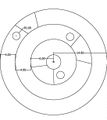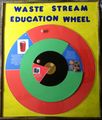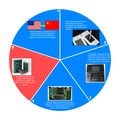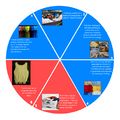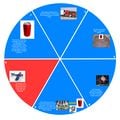The Waste Stream Education Wheel was designed in the Cal Poly Humboldt Engineering 215 class to be an educational tool for use by SCRAP Humboldt. The wheel targets third through eighth graders, and teaches how three everyday objects go through the waste stream.
Background[edit | edit source]
The client is SCRAP Humboldt (School Community Reuse Action Project), an up-cycling center based out of Humboldt County that implements education and affordable materials. This helps to promote their goal of environmentally sustainable behavior and creative reuse. In order to promote their values to the public, they seek a tool that they can use in their facility for educating the youth about the waste stream.[1]
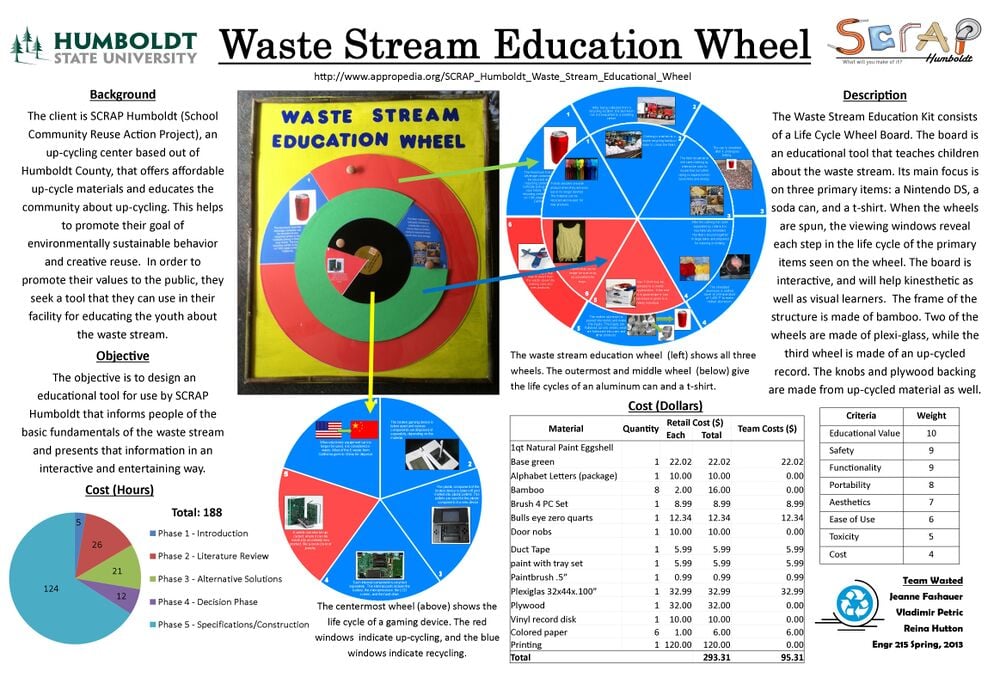
Problem Statement and Criteria[edit | edit source]
The objective is to design an educational tool that informs people of the basic fundamentals of the waste stream and presents that information in an interactive and entertaining way. The criteria are neccessities to help find the best alternative solution for the client's vision.
| Criteria | Weight | Description |
|---|---|---|
| Cost | 4 | The total expenses are less than $300. |
| Aesthetics | 7 | When anyone observes the project, the appearance is professional and unique. |
| Education Value | 10 | The solution provides information on the waste stream for K-8. |
| Portability | 8 | The item is able to be carried by one person |
| Safety | 9 | The project is harm free, with sharp items absent. |
| Ease of Use | 6 | A child can use the project. |
| Functionality | 9 | Is interactive and has more than one purpose. |
| Toxicity | 5 | The project is durable and has no toxicity. |
Description of final project[edit | edit source]
The Waste Stream Education Wheel is an educational tool that teaches children about the waste stream. Its main focus is on three primary items: a gaming device, an aluminum can, and a t-shirt. When the wheel is spun, the viewing window reveals each step in the life cycle of the primary item seen on the wheel. The board is interactive, and will help kinesthetic as well as visual type learners. The frame of the structure is made of bamboo. Two of the wheels are made of plexiglass, while the third wheel is made of an upcycled record. The knobs are upcycled as well.
Costs[edit | edit source]
SCRAP Humboldt and local businesses donated many materials. The retail cost is based on prices from local stores.
| Material | Quantity | Retail Cost ($) | Price Paid ($) |
|---|---|---|---|
| 1qt Natural Paint Eggshell Base green | 12 | 24.00 | Donated |
| Alphabet Letters (package) | 1 | 10.00 | 0.00 |
| Bamboo | 8 | 16.00 | 0.00 |
| Brush 4 PC Set | 1 | 8.99 | 8.99 |
| Bulls eye zero quarts | 1 | 12.34 | 12.34 |
| Duck Tape | 1 | 5.99 | 5.99 |
| Paint with tray set | 1 | 5.99 | 5.99 |
| Knobs | 1 | 10.00 | 0.00 |
| Vinyl Record Disk | 1 | 10.00 | 0.00 |
| Plywood | 1 | 32.00 | 0.00 |
| Colored Paper | 6 | 6.00 | 6.00 |
| Paintbrush .5" | 1 | 0.99 | 0.99 |
| Plexiglas 32x44x.100" | 1 | 32.99 | 32.99 |
| Totals: | $173.31 | $95.31 |
How to build[edit | edit source]
The Waste Stream Education Wheel consists of three wheels fashioned out of plexiglass and a vinyl record. They are connected to a plywood backing with a bamboo frame for additional support. Each wheel has an up-cycled cabinet knob used to spin the wheels independently. A cut is made on each wheel for a viewing window to display information corresponding to each waste stream item.
-
Here is a basic AutoCAD sketch of a the bamboo frame.
-
A rough idea of how the wheels would look.
-
Project Design
-
The Inner most wheel showing an example of e-waste.
-
The Middle wheel showing a t-shirt.
-
The Outer wheel showing a soda can.
References[edit | edit source]
See for more.

